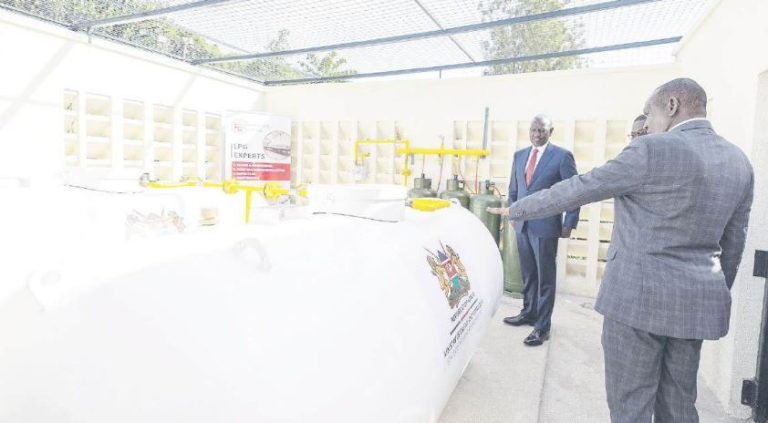Kenya is looking to ride on the School Liquefied Petroleum Gas (LPG) programme and the new code of construction to double the uptake of clean cooking solutions in the country.
Energy and Petroleum Regulatory Authority says that it is banking on a combination of policy and infrastructure interventions to implement its energy plan.
Energy and Petroleum Regulatory Authority (EPRA) Director General Daniel Kiptoo acknowledged that the project is behind schedule, even as he noted that the mapping of the schools and their LPG requirements is complete.
“As we said earlier, the project is behind schedule, and we are approaching this from both ends. First, by expanding import and storage infrastructure, and second, by ensuring accessibility at the consumer level — particularly through schools and household-level reticulation,” Kiptoo said.
Despite the School LPG Program being seen as a key driver of the demand, the country is still lagging in the adoption plan, with only 20 schools having installed the system.
This is against the planned 11,000 institutions targeted by December 2025.
According to the State Department for Petroleum, the LPG adoption project in the remaining 10,980 institutions will be developed in partnership with the private sector, before moving to affordable housing projects, police stations, public hospitals, prisons, among other government institutions.
Kenya’s push for clean energy has been gaining momentum, with the consumption of cooking gas in Kenya increasing by 15 per cent in 2024 as households continued to ditch dirty fuels such as kerosene, whose usage dropped by 32 per cent.
The use of Liquefied Petroleum Gas (LPG) went up to 414,880 metric tons over the 12 months to December last year from 360,590 metric tons in 2023, according to data by the Kenya National Bureau of Statistics (KNBS).
This is even as kerosene consumption dropped to 37,120 metric tons last year from 54,620 metric tons in 2023.
The Biannual energy and petroleum statistics report for the financial year 2024-25 shows that LPG consumption has since increased to 414,861 metric tons, up from 360,592 metric tonnes in 2023 and 333,829 in 2022.
“The LPG per capita usage in the previous year we were 7.5 kilograms; we are hoping that we’ll get 15 kilos in the next three years with the implementation of the LPG Gas Strategy,” said Kiptoo
According to the commissioner general for petroleum, in the ministry of energy, Joseph Otieno, with the government pushing for institutions to transition to clean energy cooking solutions, the ministry is eyeing partnerships with banks and financiers.
Further to enhance LPG penetration from 24 per cent to 70 per cent by 2028, the program will be implemented through collaboration between the Energy and Housing ministries as well as the private sector.
New building codes now require LPG piping systems in all high-rise buildings — a regulation introduced by the National Construction Authority (NCA) — to support wider household adoption.
Otieno says that the push is because one school alone may clear up to 56 acres of forest each year to meet its cooking needs.
“The statistics before us are sobering. In Kenya, nearly 90 per cent of schools rely on firewood for cooking, with the education sector consuming an estimated 10 million trees annually,” said Otieno.
To meet the expected rise in demand, the state has been rushing to establish a common-user import facility at the Kenya Petroleum Refineries Limited in partnership with the private sector and incorporating the LPG ecosystem in all major projects to fast-track affordable energy solutions.
Kiptoo maintains that to meet the expected demand, Kenya is significantly boosting its LPG import and storage capacity along the coast.
The Africa Gas and Oil facility in Mombasa now has 25,000 metric tons of storage. Lead Gas’s new 10,000 metric ton terminal in Vipingo recently received its first LPG shipment and is currently under commissioning.
Further, a proposed project by Kenya Pipeline Company (KPC) in partnership with Ashrami aims to add 30,000 metric tons of capacity at the Kenya Petroleum Refineries Ltd (KPRL) site, and Taifa Gas is also constructing another 30,000 metric tonnes terminal at Dongo Kundu.
Kiptoo confirmed that import-level expansion is progressing smoothly, with collaboration from both public and private sector players.
The State Department for Petroleum sought to spend Sh2.5 billion from the fuel anti-adulteration levy on the construction of gas facilities in schools and public institutions.
However, in the budget read last week, Thursday, National Treasury Cabinet Secretary John Mbadi didn’t disclose how much had been set aside specifically for this program.
“We’re also working closely with the Council of Governors to ensure that county governments incorporate LPG piping in approved building plans, a critical role of county-level planning in implementing the strategy,” added Kiptoo.
The government hopes the dual approach — scaling up supply and building in demand from institutions and households — will accelerate Kenya’s transition to cleaner cooking fuels and reduce reliance on harmful biomass sources.
by JACKTONE LAWI


